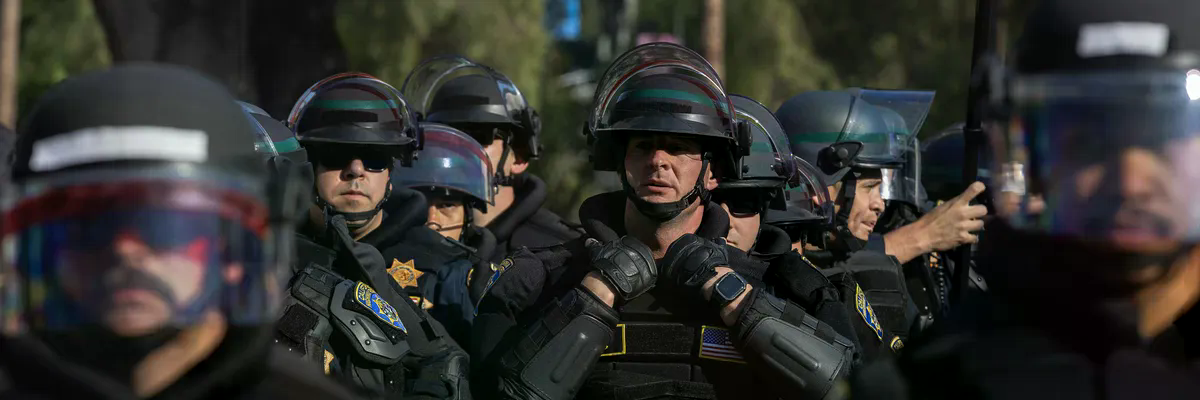
State and local governments have allocated hundreds of millions of taxpayer dollars to equip police forces with military-style equipment through a secretive federal program, according to a recent report. The 1122 Program, established in 1994, enables states and municipalities to purchase discounted military-grade gear from the federal government, raising concerns about its use and transparency.
The report, published by Women for Weapons Trade Transparency—a part of the Center for International Policy—found that over $126 million in purchases were recorded across 13 states, four cities, and two counties since the program’s inception. Based on this data, the group estimates total spending nationwide could be in the “upper hundreds of millions of dollars.” The lack of standardized record-keeping necessitated the use of open records requests to gather the information.
Rosie Khan, co-founder of Women for Weapons Trade Transparency, criticized the program, stating it diverts public funds from essential community needs toward militarized policing. She noted that the $126.87 million spent on such equipment could have been used to support housing, provide school meals, or repair infrastructure.
Congress created the 1122 Program during the height of the War on Drugs, authorizing it under the 1994 National Defense Authorization Act to assist police departments in counter-drug operations. While similar to the more well-known 1033 Program—which has distributed over $7 billion in surplus military equipment—the 1122 Program differs in several key aspects. Unlike the 1033 Program, which transfers unused military equipment, the 1122 Program allows states and cities to spend public funds to purchase new equipment.
The program’s scope expanded significantly in 2009 when “homeland security” and “emergency response” missions were added to its objectives. However, the report notes that no regulatory mechanisms ensure that the equipment is used solely for these purposes. The definition of these missions remains unclear, raising further concerns about oversight and accountability.
Over time, the program has increasingly been used to supply police with tools deployed against protesters. This includes $6.2 million allocated for weapons, training, and riot gear, such as pepper spray, batons, gas masks, and riot shields. The largest portion of spending went toward armored vehicles, with over $85 million spent on trucks, vans, and sedans. Police departments also spent an additional $6 million to acquire at least 16 Lenco BearCats, each costing around $300,000. These vehicles were used in suppressing protests following the murder of George Floyd in 2020.
Recent incidents highlight the continued use of such equipment. On October 3, 2025, Immigration and Customs Enforcement (ICE) officers were seen aboard a Bearcat near a detention facility in Illinois, equipped with military gear and threatening protesters. In July, Los Angeles ICE agents were filmed using a vehicle to run over demonstrators attempting to block their path.
Another $9.6 million was spent on surveillance technology, including license plate readers, video and audio recording devices, and software for facial recognition and social media monitoring. The report emphasizes the growing use of such tools by college police departments, including Northern Virginia Community College, which spent over $2.7 million on surveillance tech. These technologies have been used to target student activists, particularly during pro-Palestine demonstrations.
At Yale University, where surveillance cameras, drones, and social media tracking are standard tools, a student was recently charged with a felony for removing an American flag from a pole, using the university’s surveillance system.
The report calls for Congress to terminate the 1122 Program and redirect its funding toward public safety models that emphasize care, accountability, and community well-being. It urges lawmakers to act urgently to prevent a potential escalation of surveillance, criminalization, and force by law enforcement and federal agencies.
The authors note that the program’s expansion has coincided with increased political tensions, including the reversal of a Biden-era executive order by President Donald Trump, which restricted the sale of certain military-style weapons to local police. This shift has raised concerns about the growing militarization of law enforcement and its impact on civil liberties.
Nancy Okail, president and CEO of the Center for International Policy, stated that tax dollars are being used to “weaponize” citizens under the guise of “domestic terrorism.” She warned that rhetoric about a “war from within” risks fueling real attacks on democracy and civil rights.


